The Marketing of Products to Children
VerifiedAdded on 2021/05/30
|20
|5044
|22
AI Summary
Contribute Materials
Your contribution can guide someone’s learning journey. Share your
documents today.

The Analysis of Children Market for Advertising in India
Student’s Name:
Institution:
The Ice Cream’s Market in India
Student’s Name:
Institution:
The Ice Cream’s Market in India
Secure Best Marks with AI Grader
Need help grading? Try our AI Grader for instant feedback on your assignments.
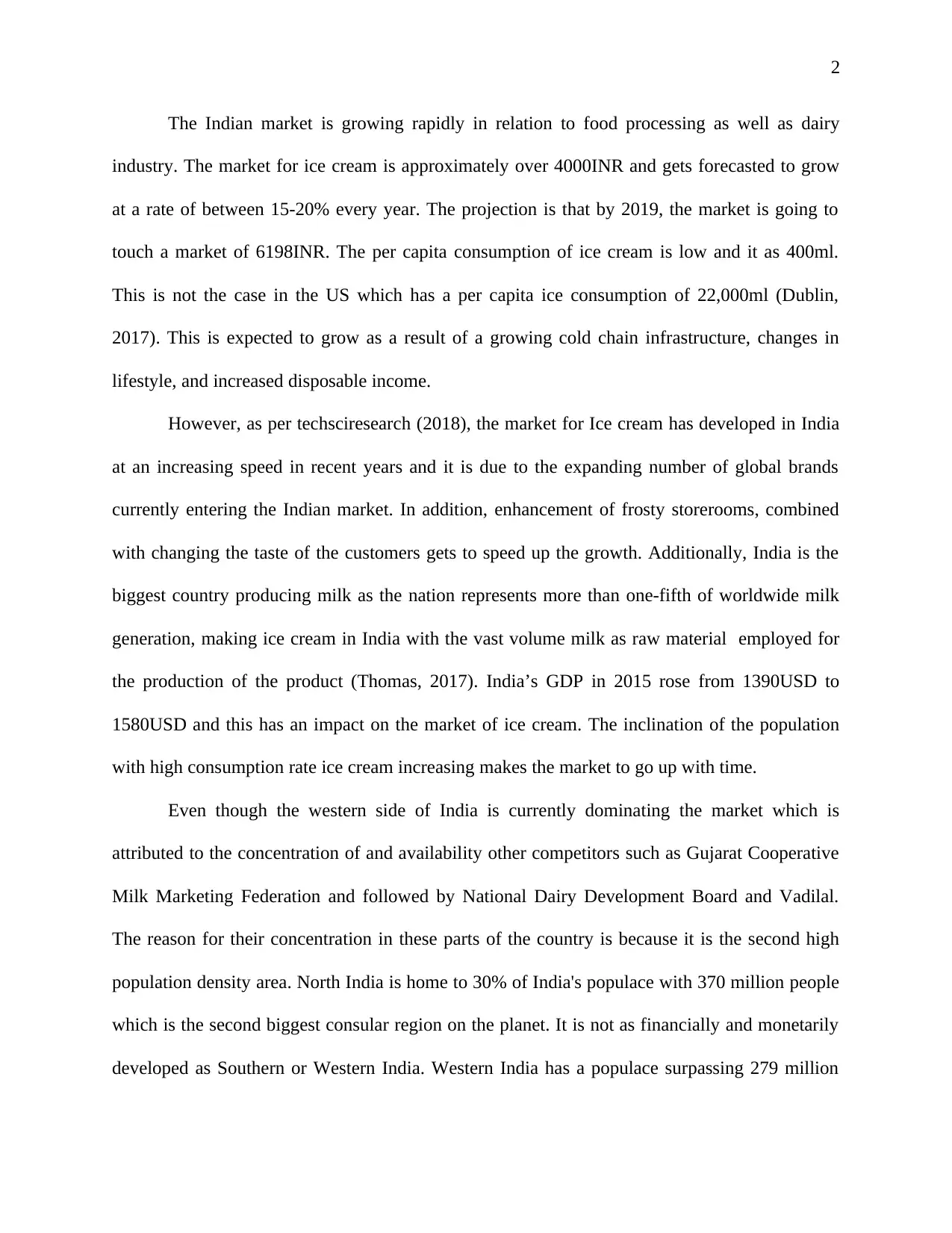
2
The Indian market is growing rapidly in relation to food processing as well as dairy
industry. The market for ice cream is approximately over 4000INR and gets forecasted to grow
at a rate of between 15-20% every year. The projection is that by 2019, the market is going to
touch a market of 6198INR. The per capita consumption of ice cream is low and it as 400ml.
This is not the case in the US which has a per capita ice consumption of 22,000ml (Dublin,
2017). This is expected to grow as a result of a growing cold chain infrastructure, changes in
lifestyle, and increased disposable income.
However, as per techsciresearch (2018), the market for Ice cream has developed in India
at an increasing speed in recent years and it is due to the expanding number of global brands
currently entering the Indian market. In addition, enhancement of frosty storerooms, combined
with changing the taste of the customers gets to speed up the growth. Additionally, India is the
biggest country producing milk as the nation represents more than one-fifth of worldwide milk
generation, making ice cream in India with the vast volume milk as raw material employed for
the production of the product (Thomas, 2017). India’s GDP in 2015 rose from 1390USD to
1580USD and this has an impact on the market of ice cream. The inclination of the population
with high consumption rate ice cream increasing makes the market to go up with time.
Even though the western side of India is currently dominating the market which is
attributed to the concentration of and availability other competitors such as Gujarat Cooperative
Milk Marketing Federation and followed by National Dairy Development Board and Vadilal.
The reason for their concentration in these parts of the country is because it is the second high
population density area. North India is home to 30% of India's populace with 370 million people
which is the second biggest consular region on the planet. It is not as financially and monetarily
developed as Southern or Western India. Western India has a populace surpassing 279 million
The Indian market is growing rapidly in relation to food processing as well as dairy
industry. The market for ice cream is approximately over 4000INR and gets forecasted to grow
at a rate of between 15-20% every year. The projection is that by 2019, the market is going to
touch a market of 6198INR. The per capita consumption of ice cream is low and it as 400ml.
This is not the case in the US which has a per capita ice consumption of 22,000ml (Dublin,
2017). This is expected to grow as a result of a growing cold chain infrastructure, changes in
lifestyle, and increased disposable income.
However, as per techsciresearch (2018), the market for Ice cream has developed in India
at an increasing speed in recent years and it is due to the expanding number of global brands
currently entering the Indian market. In addition, enhancement of frosty storerooms, combined
with changing the taste of the customers gets to speed up the growth. Additionally, India is the
biggest country producing milk as the nation represents more than one-fifth of worldwide milk
generation, making ice cream in India with the vast volume milk as raw material employed for
the production of the product (Thomas, 2017). India’s GDP in 2015 rose from 1390USD to
1580USD and this has an impact on the market of ice cream. The inclination of the population
with high consumption rate ice cream increasing makes the market to go up with time.
Even though the western side of India is currently dominating the market which is
attributed to the concentration of and availability other competitors such as Gujarat Cooperative
Milk Marketing Federation and followed by National Dairy Development Board and Vadilal.
The reason for their concentration in these parts of the country is because it is the second high
population density area. North India is home to 30% of India's populace with 370 million people
which is the second biggest consular region on the planet. It is not as financially and monetarily
developed as Southern or Western India. Western India has a populace surpassing 279 million

3
people. The area is centered in Mumbai which is the monetary, business and entertainment
capital of the nation. South India has the populace of 290 million people and Eastern India has a
populace of roughly 270 million people. All the regions are populated representing a sizeable
market with the Northern, Southern and Eastern regions not targeted by the regional players in
ice cream industry (techsciresearch, 2018).
The Differences between India and US
Irrespective of the commonalities existing from democratic governments and English use
in India and the U.S., the cultural differences is another aspect not to be ignored. India and USA
were both colonies of the British, however, the invasion of Asian influence has resulted in India
have different blends of Muslim, Buddhism, and Hinduism with Hinduism being dominant.
These blends make India very unique from other British colonies (Elischberger et al., 2018) The
US’s British colonization almost eradicated native tribes’ indigenous culture by replacing with
democracy, capitalism, and Christianity of which Christianity is dominant. The root of British
colonization creates elements that allow the two countries facilitate global business. These
countries roots their societies from the British Empire hence people in these nations get are
acquainted with the governance systems, rule of law and established bureaucracies. The English
language becomes a common tool of communication (Fernando and Moore, 2015). The US is a
low-context culture where communication is explicit with little room for understanding whereas
India the communication is a high-context where communication leaves other things that require
explanation in relation to culture. The US depends on the explicit language in relation to
professional code of conduct whereas India relies on relationships which are less explicit
(Eisenbeiß and Brodbeck, 2014). These differences in context can have an impact in the process
of making the decision. The managers from India see the difficulty in decision making; they take
people. The area is centered in Mumbai which is the monetary, business and entertainment
capital of the nation. South India has the populace of 290 million people and Eastern India has a
populace of roughly 270 million people. All the regions are populated representing a sizeable
market with the Northern, Southern and Eastern regions not targeted by the regional players in
ice cream industry (techsciresearch, 2018).
The Differences between India and US
Irrespective of the commonalities existing from democratic governments and English use
in India and the U.S., the cultural differences is another aspect not to be ignored. India and USA
were both colonies of the British, however, the invasion of Asian influence has resulted in India
have different blends of Muslim, Buddhism, and Hinduism with Hinduism being dominant.
These blends make India very unique from other British colonies (Elischberger et al., 2018) The
US’s British colonization almost eradicated native tribes’ indigenous culture by replacing with
democracy, capitalism, and Christianity of which Christianity is dominant. The root of British
colonization creates elements that allow the two countries facilitate global business. These
countries roots their societies from the British Empire hence people in these nations get are
acquainted with the governance systems, rule of law and established bureaucracies. The English
language becomes a common tool of communication (Fernando and Moore, 2015). The US is a
low-context culture where communication is explicit with little room for understanding whereas
India the communication is a high-context where communication leaves other things that require
explanation in relation to culture. The US depends on the explicit language in relation to
professional code of conduct whereas India relies on relationships which are less explicit
(Eisenbeiß and Brodbeck, 2014). These differences in context can have an impact in the process
of making the decision. The managers from India see the difficulty in decision making; they take
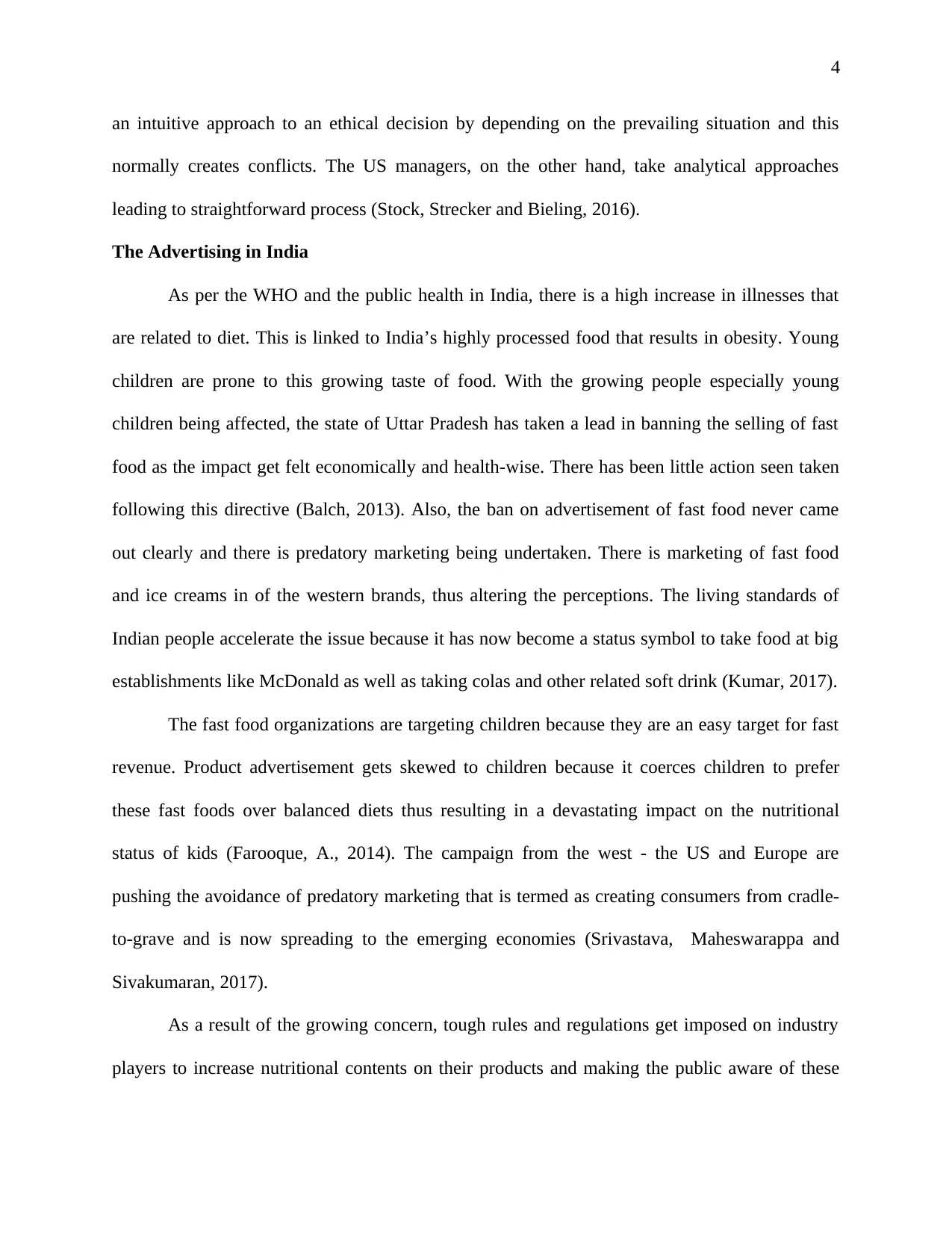
4
an intuitive approach to an ethical decision by depending on the prevailing situation and this
normally creates conflicts. The US managers, on the other hand, take analytical approaches
leading to straightforward process (Stock, Strecker and Bieling, 2016).
The Advertising in India
As per the WHO and the public health in India, there is a high increase in illnesses that
are related to diet. This is linked to India’s highly processed food that results in obesity. Young
children are prone to this growing taste of food. With the growing people especially young
children being affected, the state of Uttar Pradesh has taken a lead in banning the selling of fast
food as the impact get felt economically and health-wise. There has been little action seen taken
following this directive (Balch, 2013). Also, the ban on advertisement of fast food never came
out clearly and there is predatory marketing being undertaken. There is marketing of fast food
and ice creams in of the western brands, thus altering the perceptions. The living standards of
Indian people accelerate the issue because it has now become a status symbol to take food at big
establishments like McDonald as well as taking colas and other related soft drink (Kumar, 2017).
The fast food organizations are targeting children because they are an easy target for fast
revenue. Product advertisement gets skewed to children because it coerces children to prefer
these fast foods over balanced diets thus resulting in a devastating impact on the nutritional
status of kids (Farooque, A., 2014). The campaign from the west - the US and Europe are
pushing the avoidance of predatory marketing that is termed as creating consumers from cradle-
to-grave and is now spreading to the emerging economies (Srivastava, Maheswarappa and
Sivakumaran, 2017).
As a result of the growing concern, tough rules and regulations get imposed on industry
players to increase nutritional contents on their products and making the public aware of these
an intuitive approach to an ethical decision by depending on the prevailing situation and this
normally creates conflicts. The US managers, on the other hand, take analytical approaches
leading to straightforward process (Stock, Strecker and Bieling, 2016).
The Advertising in India
As per the WHO and the public health in India, there is a high increase in illnesses that
are related to diet. This is linked to India’s highly processed food that results in obesity. Young
children are prone to this growing taste of food. With the growing people especially young
children being affected, the state of Uttar Pradesh has taken a lead in banning the selling of fast
food as the impact get felt economically and health-wise. There has been little action seen taken
following this directive (Balch, 2013). Also, the ban on advertisement of fast food never came
out clearly and there is predatory marketing being undertaken. There is marketing of fast food
and ice creams in of the western brands, thus altering the perceptions. The living standards of
Indian people accelerate the issue because it has now become a status symbol to take food at big
establishments like McDonald as well as taking colas and other related soft drink (Kumar, 2017).
The fast food organizations are targeting children because they are an easy target for fast
revenue. Product advertisement gets skewed to children because it coerces children to prefer
these fast foods over balanced diets thus resulting in a devastating impact on the nutritional
status of kids (Farooque, A., 2014). The campaign from the west - the US and Europe are
pushing the avoidance of predatory marketing that is termed as creating consumers from cradle-
to-grave and is now spreading to the emerging economies (Srivastava, Maheswarappa and
Sivakumaran, 2017).
As a result of the growing concern, tough rules and regulations get imposed on industry
players to increase nutritional contents on their products and making the public aware of these
Secure Best Marks with AI Grader
Need help grading? Try our AI Grader for instant feedback on your assignments.
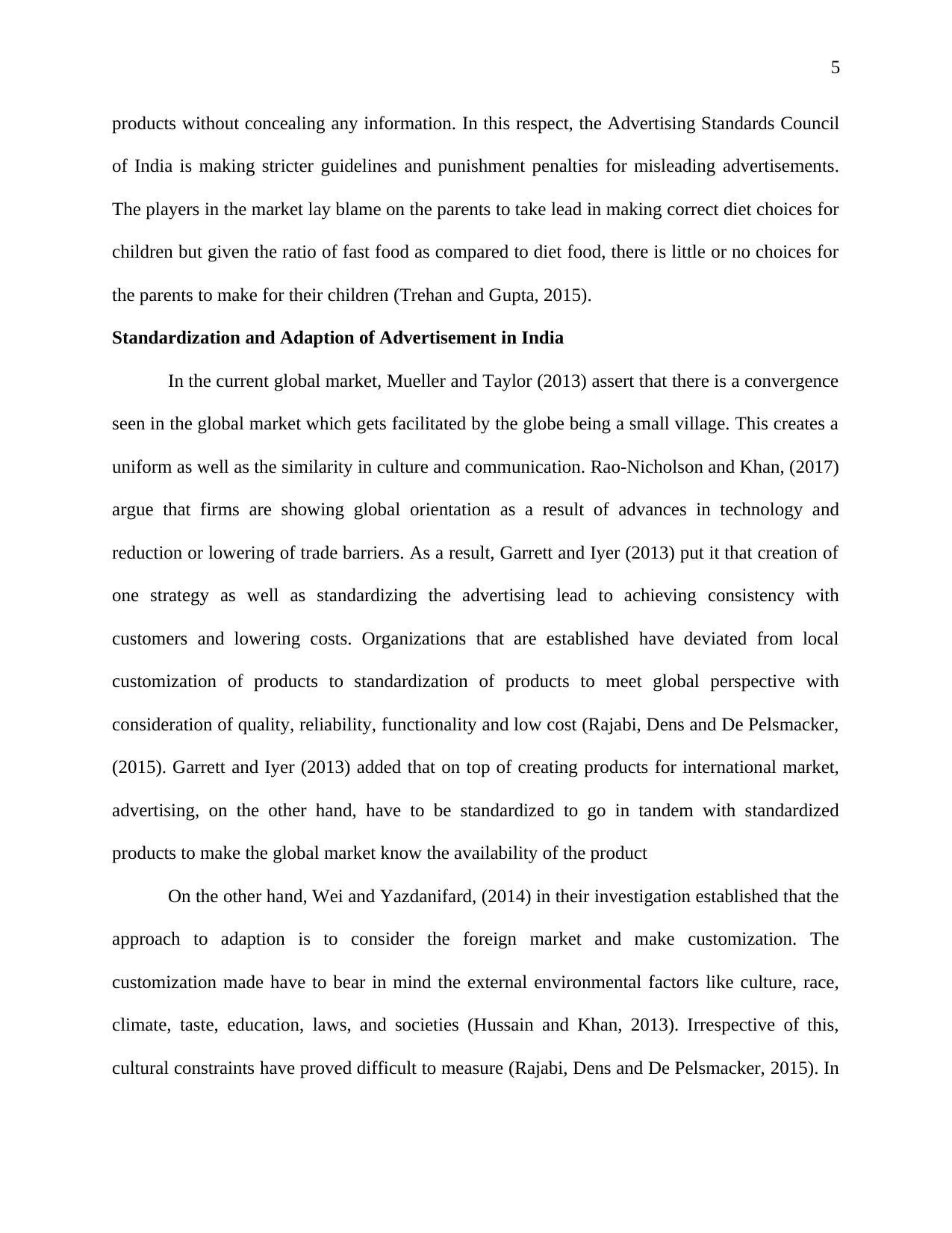
5
products without concealing any information. In this respect, the Advertising Standards Council
of India is making stricter guidelines and punishment penalties for misleading advertisements.
The players in the market lay blame on the parents to take lead in making correct diet choices for
children but given the ratio of fast food as compared to diet food, there is little or no choices for
the parents to make for their children (Trehan and Gupta, 2015).
Standardization and Adaption of Advertisement in India
In the current global market, Mueller and Taylor (2013) assert that there is a convergence
seen in the global market which gets facilitated by the globe being a small village. This creates a
uniform as well as the similarity in culture and communication. Rao-Nicholson and Khan, (2017)
argue that firms are showing global orientation as a result of advances in technology and
reduction or lowering of trade barriers. As a result, Garrett and Iyer (2013) put it that creation of
one strategy as well as standardizing the advertising lead to achieving consistency with
customers and lowering costs. Organizations that are established have deviated from local
customization of products to standardization of products to meet global perspective with
consideration of quality, reliability, functionality and low cost (Rajabi, Dens and De Pelsmacker,
(2015). Garrett and Iyer (2013) added that on top of creating products for international market,
advertising, on the other hand, have to be standardized to go in tandem with standardized
products to make the global market know the availability of the product
On the other hand, Wei and Yazdanifard, (2014) in their investigation established that the
approach to adaption is to consider the foreign market and make customization. The
customization made have to bear in mind the external environmental factors like culture, race,
climate, taste, education, laws, and societies (Hussain and Khan, 2013). Irrespective of this,
cultural constraints have proved difficult to measure (Rajabi, Dens and De Pelsmacker, 2015). In
products without concealing any information. In this respect, the Advertising Standards Council
of India is making stricter guidelines and punishment penalties for misleading advertisements.
The players in the market lay blame on the parents to take lead in making correct diet choices for
children but given the ratio of fast food as compared to diet food, there is little or no choices for
the parents to make for their children (Trehan and Gupta, 2015).
Standardization and Adaption of Advertisement in India
In the current global market, Mueller and Taylor (2013) assert that there is a convergence
seen in the global market which gets facilitated by the globe being a small village. This creates a
uniform as well as the similarity in culture and communication. Rao-Nicholson and Khan, (2017)
argue that firms are showing global orientation as a result of advances in technology and
reduction or lowering of trade barriers. As a result, Garrett and Iyer (2013) put it that creation of
one strategy as well as standardizing the advertising lead to achieving consistency with
customers and lowering costs. Organizations that are established have deviated from local
customization of products to standardization of products to meet global perspective with
consideration of quality, reliability, functionality and low cost (Rajabi, Dens and De Pelsmacker,
(2015). Garrett and Iyer (2013) added that on top of creating products for international market,
advertising, on the other hand, have to be standardized to go in tandem with standardized
products to make the global market know the availability of the product
On the other hand, Wei and Yazdanifard, (2014) in their investigation established that the
approach to adaption is to consider the foreign market and make customization. The
customization made have to bear in mind the external environmental factors like culture, race,
climate, taste, education, laws, and societies (Hussain and Khan, 2013). Irrespective of this,
cultural constraints have proved difficult to measure (Rajabi, Dens and De Pelsmacker, 2015). In
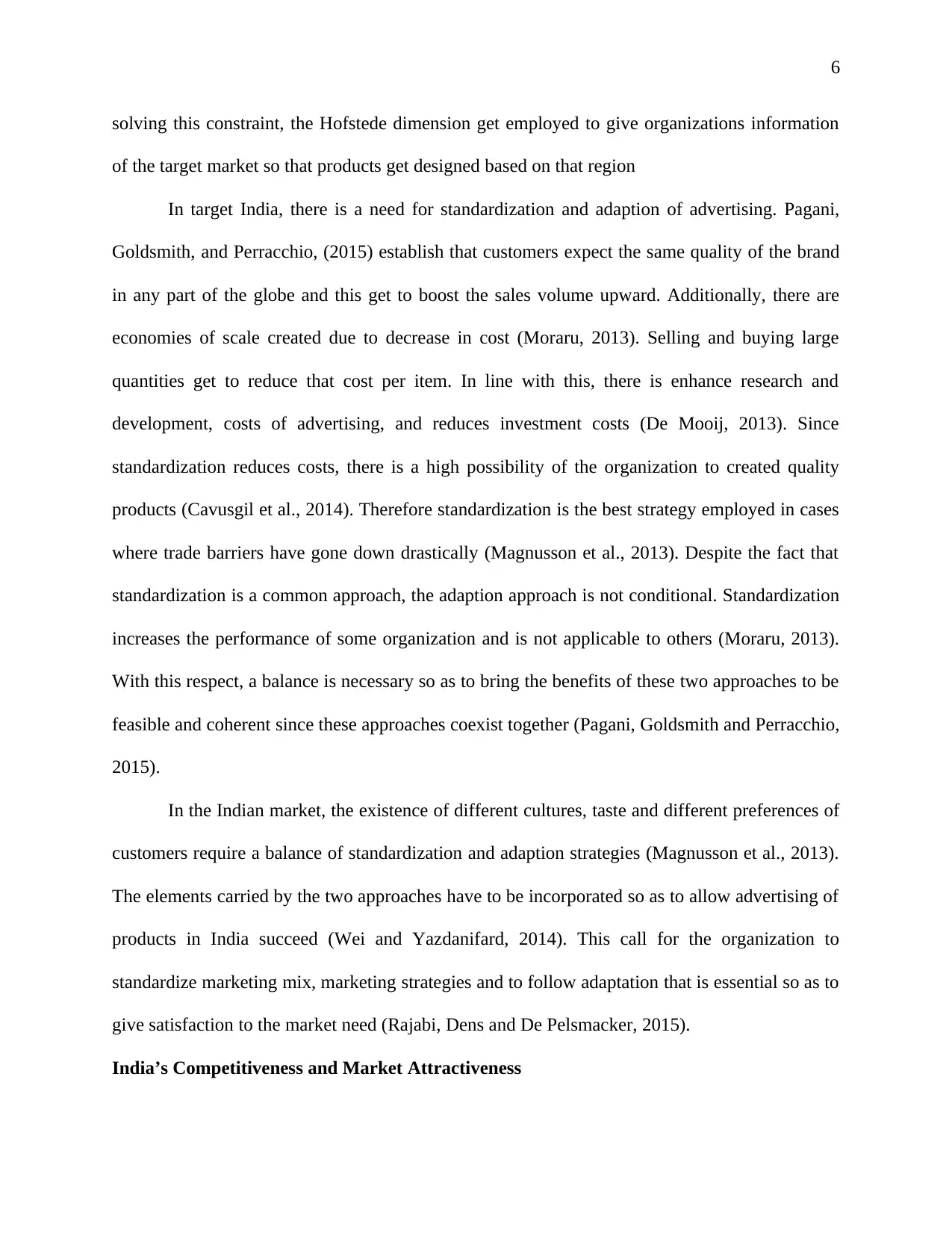
6
solving this constraint, the Hofstede dimension get employed to give organizations information
of the target market so that products get designed based on that region
In target India, there is a need for standardization and adaption of advertising. Pagani,
Goldsmith, and Perracchio, (2015) establish that customers expect the same quality of the brand
in any part of the globe and this get to boost the sales volume upward. Additionally, there are
economies of scale created due to decrease in cost (Moraru, 2013). Selling and buying large
quantities get to reduce that cost per item. In line with this, there is enhance research and
development, costs of advertising, and reduces investment costs (De Mooij, 2013). Since
standardization reduces costs, there is a high possibility of the organization to created quality
products (Cavusgil et al., 2014). Therefore standardization is the best strategy employed in cases
where trade barriers have gone down drastically (Magnusson et al., 2013). Despite the fact that
standardization is a common approach, the adaption approach is not conditional. Standardization
increases the performance of some organization and is not applicable to others (Moraru, 2013).
With this respect, a balance is necessary so as to bring the benefits of these two approaches to be
feasible and coherent since these approaches coexist together (Pagani, Goldsmith and Perracchio,
2015).
In the Indian market, the existence of different cultures, taste and different preferences of
customers require a balance of standardization and adaption strategies (Magnusson et al., 2013).
The elements carried by the two approaches have to be incorporated so as to allow advertising of
products in India succeed (Wei and Yazdanifard, 2014). This call for the organization to
standardize marketing mix, marketing strategies and to follow adaptation that is essential so as to
give satisfaction to the market need (Rajabi, Dens and De Pelsmacker, 2015).
India’s Competitiveness and Market Attractiveness
solving this constraint, the Hofstede dimension get employed to give organizations information
of the target market so that products get designed based on that region
In target India, there is a need for standardization and adaption of advertising. Pagani,
Goldsmith, and Perracchio, (2015) establish that customers expect the same quality of the brand
in any part of the globe and this get to boost the sales volume upward. Additionally, there are
economies of scale created due to decrease in cost (Moraru, 2013). Selling and buying large
quantities get to reduce that cost per item. In line with this, there is enhance research and
development, costs of advertising, and reduces investment costs (De Mooij, 2013). Since
standardization reduces costs, there is a high possibility of the organization to created quality
products (Cavusgil et al., 2014). Therefore standardization is the best strategy employed in cases
where trade barriers have gone down drastically (Magnusson et al., 2013). Despite the fact that
standardization is a common approach, the adaption approach is not conditional. Standardization
increases the performance of some organization and is not applicable to others (Moraru, 2013).
With this respect, a balance is necessary so as to bring the benefits of these two approaches to be
feasible and coherent since these approaches coexist together (Pagani, Goldsmith and Perracchio,
2015).
In the Indian market, the existence of different cultures, taste and different preferences of
customers require a balance of standardization and adaption strategies (Magnusson et al., 2013).
The elements carried by the two approaches have to be incorporated so as to allow advertising of
products in India succeed (Wei and Yazdanifard, 2014). This call for the organization to
standardize marketing mix, marketing strategies and to follow adaptation that is essential so as to
give satisfaction to the market need (Rajabi, Dens and De Pelsmacker, 2015).
India’s Competitiveness and Market Attractiveness
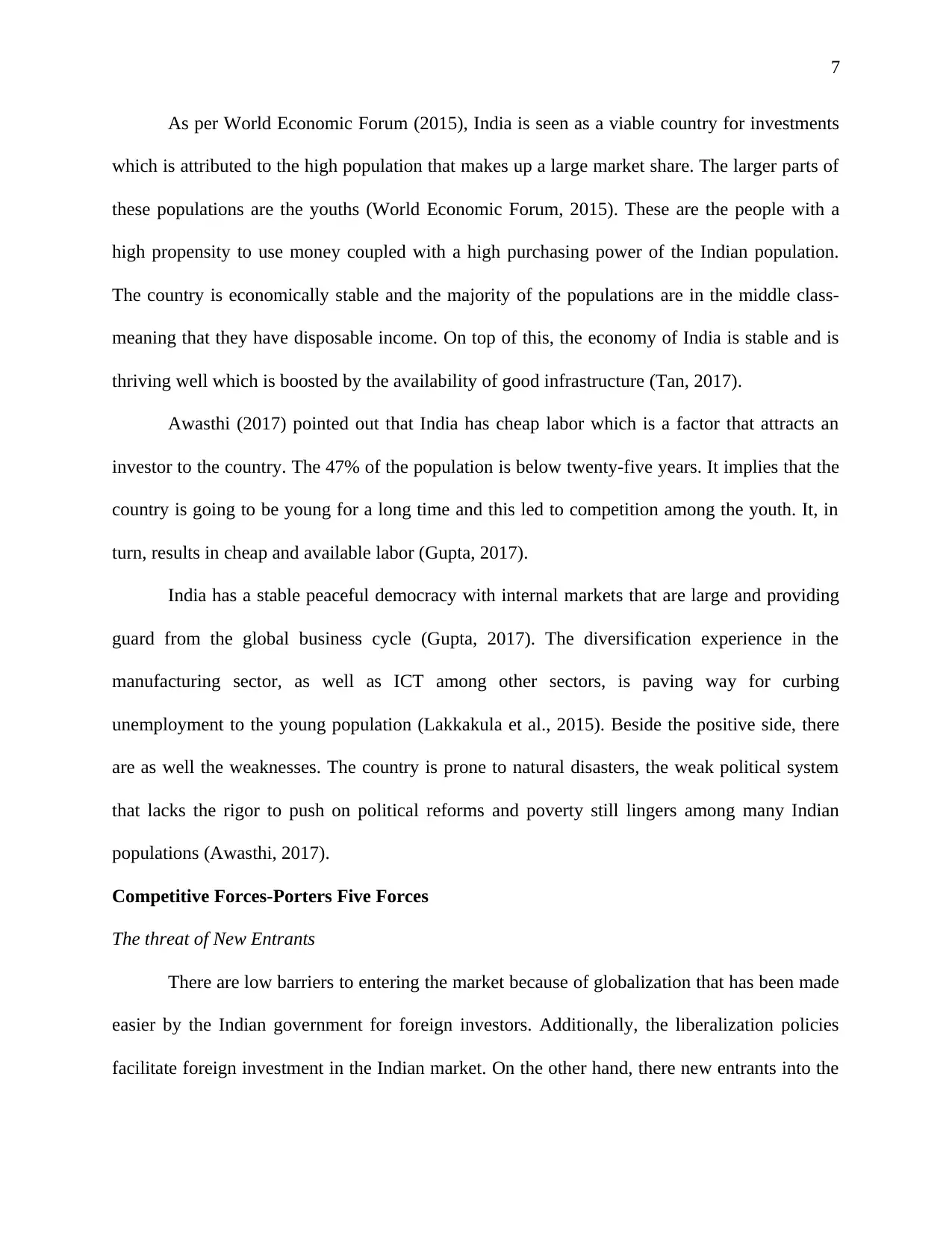
7
As per World Economic Forum (2015), India is seen as a viable country for investments
which is attributed to the high population that makes up a large market share. The larger parts of
these populations are the youths (World Economic Forum, 2015). These are the people with a
high propensity to use money coupled with a high purchasing power of the Indian population.
The country is economically stable and the majority of the populations are in the middle class-
meaning that they have disposable income. On top of this, the economy of India is stable and is
thriving well which is boosted by the availability of good infrastructure (Tan, 2017).
Awasthi (2017) pointed out that India has cheap labor which is a factor that attracts an
investor to the country. The 47% of the population is below twenty-five years. It implies that the
country is going to be young for a long time and this led to competition among the youth. It, in
turn, results in cheap and available labor (Gupta, 2017).
India has a stable peaceful democracy with internal markets that are large and providing
guard from the global business cycle (Gupta, 2017). The diversification experience in the
manufacturing sector, as well as ICT among other sectors, is paving way for curbing
unemployment to the young population (Lakkakula et al., 2015). Beside the positive side, there
are as well the weaknesses. The country is prone to natural disasters, the weak political system
that lacks the rigor to push on political reforms and poverty still lingers among many Indian
populations (Awasthi, 2017).
Competitive Forces-Porters Five Forces
The threat of New Entrants
There are low barriers to entering the market because of globalization that has been made
easier by the Indian government for foreign investors. Additionally, the liberalization policies
facilitate foreign investment in the Indian market. On the other hand, there new entrants into the
As per World Economic Forum (2015), India is seen as a viable country for investments
which is attributed to the high population that makes up a large market share. The larger parts of
these populations are the youths (World Economic Forum, 2015). These are the people with a
high propensity to use money coupled with a high purchasing power of the Indian population.
The country is economically stable and the majority of the populations are in the middle class-
meaning that they have disposable income. On top of this, the economy of India is stable and is
thriving well which is boosted by the availability of good infrastructure (Tan, 2017).
Awasthi (2017) pointed out that India has cheap labor which is a factor that attracts an
investor to the country. The 47% of the population is below twenty-five years. It implies that the
country is going to be young for a long time and this led to competition among the youth. It, in
turn, results in cheap and available labor (Gupta, 2017).
India has a stable peaceful democracy with internal markets that are large and providing
guard from the global business cycle (Gupta, 2017). The diversification experience in the
manufacturing sector, as well as ICT among other sectors, is paving way for curbing
unemployment to the young population (Lakkakula et al., 2015). Beside the positive side, there
are as well the weaknesses. The country is prone to natural disasters, the weak political system
that lacks the rigor to push on political reforms and poverty still lingers among many Indian
populations (Awasthi, 2017).
Competitive Forces-Porters Five Forces
The threat of New Entrants
There are low barriers to entering the market because of globalization that has been made
easier by the Indian government for foreign investors. Additionally, the liberalization policies
facilitate foreign investment in the Indian market. On the other hand, there new entrants into the
Paraphrase This Document
Need a fresh take? Get an instant paraphrase of this document with our AI Paraphraser
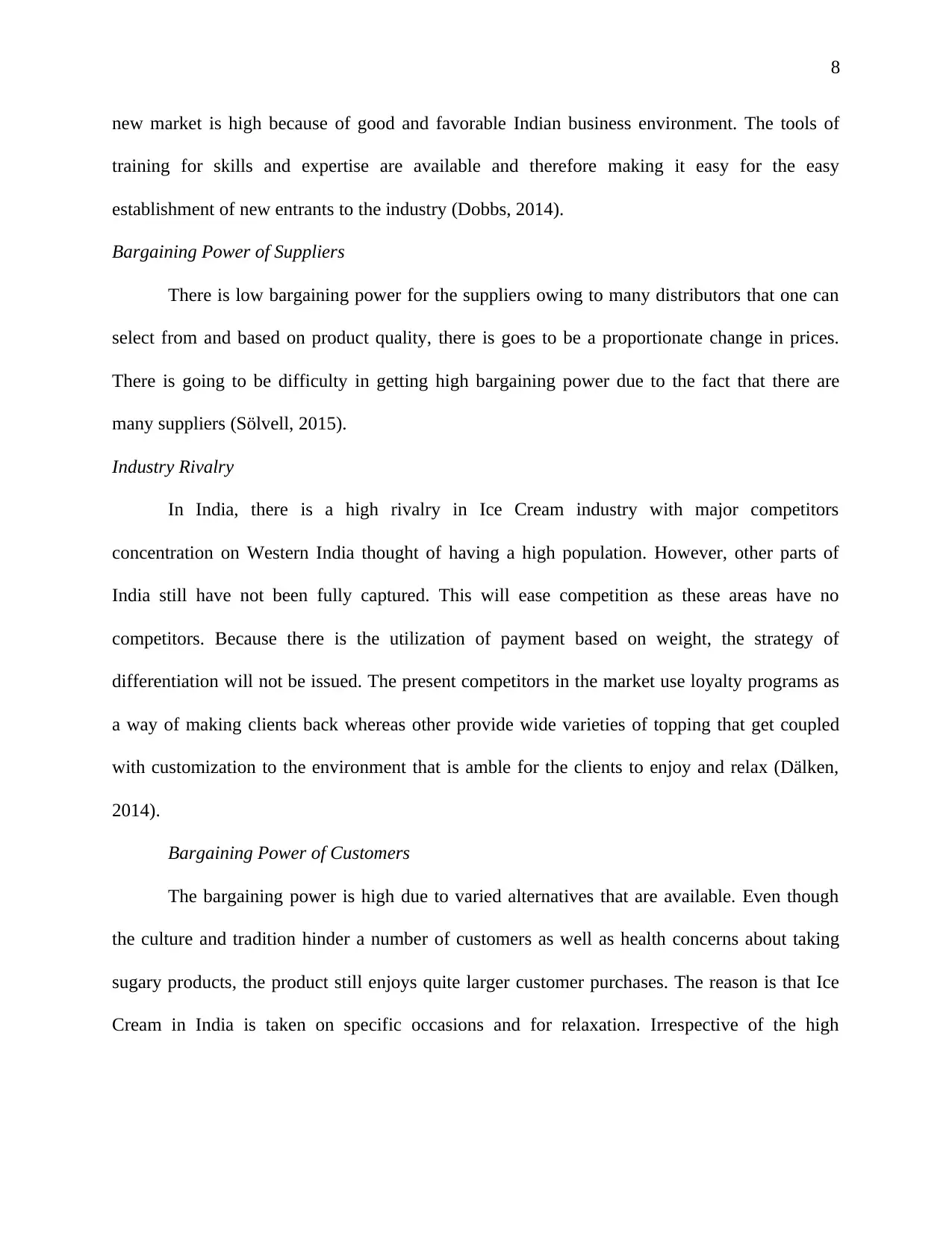
8
new market is high because of good and favorable Indian business environment. The tools of
training for skills and expertise are available and therefore making it easy for the easy
establishment of new entrants to the industry (Dobbs, 2014).
Bargaining Power of Suppliers
There is low bargaining power for the suppliers owing to many distributors that one can
select from and based on product quality, there is goes to be a proportionate change in prices.
There is going to be difficulty in getting high bargaining power due to the fact that there are
many suppliers (Sölvell, 2015).
Industry Rivalry
In India, there is a high rivalry in Ice Cream industry with major competitors
concentration on Western India thought of having a high population. However, other parts of
India still have not been fully captured. This will ease competition as these areas have no
competitors. Because there is the utilization of payment based on weight, the strategy of
differentiation will not be issued. The present competitors in the market use loyalty programs as
a way of making clients back whereas other provide wide varieties of topping that get coupled
with customization to the environment that is amble for the clients to enjoy and relax (Dälken,
2014).
Bargaining Power of Customers
The bargaining power is high due to varied alternatives that are available. Even though
the culture and tradition hinder a number of customers as well as health concerns about taking
sugary products, the product still enjoys quite larger customer purchases. The reason is that Ice
Cream in India is taken on specific occasions and for relaxation. Irrespective of the high
new market is high because of good and favorable Indian business environment. The tools of
training for skills and expertise are available and therefore making it easy for the easy
establishment of new entrants to the industry (Dobbs, 2014).
Bargaining Power of Suppliers
There is low bargaining power for the suppliers owing to many distributors that one can
select from and based on product quality, there is goes to be a proportionate change in prices.
There is going to be difficulty in getting high bargaining power due to the fact that there are
many suppliers (Sölvell, 2015).
Industry Rivalry
In India, there is a high rivalry in Ice Cream industry with major competitors
concentration on Western India thought of having a high population. However, other parts of
India still have not been fully captured. This will ease competition as these areas have no
competitors. Because there is the utilization of payment based on weight, the strategy of
differentiation will not be issued. The present competitors in the market use loyalty programs as
a way of making clients back whereas other provide wide varieties of topping that get coupled
with customization to the environment that is amble for the clients to enjoy and relax (Dälken,
2014).
Bargaining Power of Customers
The bargaining power is high due to varied alternatives that are available. Even though
the culture and tradition hinder a number of customers as well as health concerns about taking
sugary products, the product still enjoys quite larger customer purchases. The reason is that Ice
Cream in India is taken on specific occasions and for relaxation. Irrespective of the high
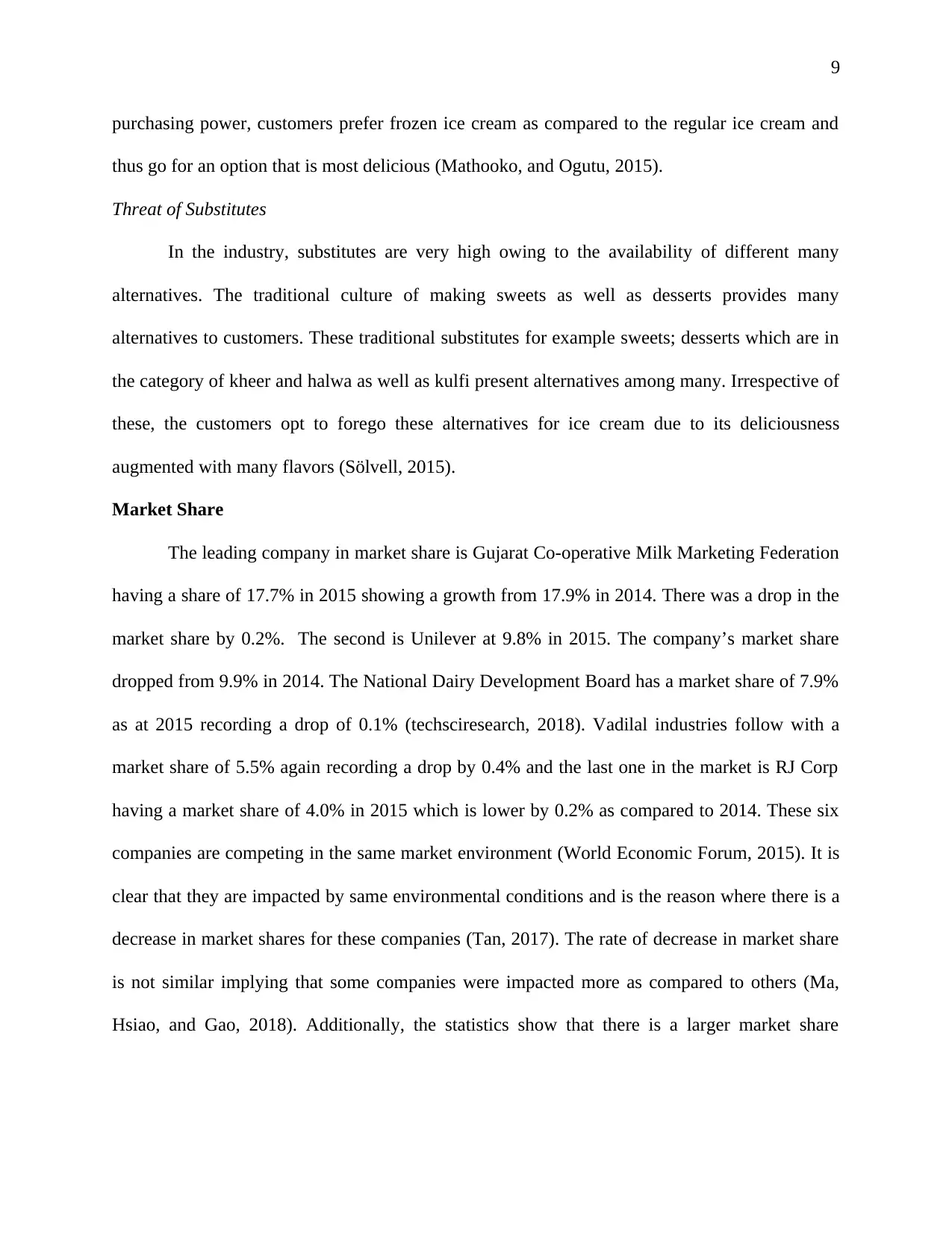
9
purchasing power, customers prefer frozen ice cream as compared to the regular ice cream and
thus go for an option that is most delicious (Mathooko, and Ogutu, 2015).
Threat of Substitutes
In the industry, substitutes are very high owing to the availability of different many
alternatives. The traditional culture of making sweets as well as desserts provides many
alternatives to customers. These traditional substitutes for example sweets; desserts which are in
the category of kheer and halwa as well as kulfi present alternatives among many. Irrespective of
these, the customers opt to forego these alternatives for ice cream due to its deliciousness
augmented with many flavors (Sölvell, 2015).
Market Share
The leading company in market share is Gujarat Co-operative Milk Marketing Federation
having a share of 17.7% in 2015 showing a growth from 17.9% in 2014. There was a drop in the
market share by 0.2%. The second is Unilever at 9.8% in 2015. The company’s market share
dropped from 9.9% in 2014. The National Dairy Development Board has a market share of 7.9%
as at 2015 recording a drop of 0.1% (techsciresearch, 2018). Vadilal industries follow with a
market share of 5.5% again recording a drop by 0.4% and the last one in the market is RJ Corp
having a market share of 4.0% in 2015 which is lower by 0.2% as compared to 2014. These six
companies are competing in the same market environment (World Economic Forum, 2015). It is
clear that they are impacted by same environmental conditions and is the reason where there is a
decrease in market shares for these companies (Tan, 2017). The rate of decrease in market share
is not similar implying that some companies were impacted more as compared to others (Ma,
Hsiao, and Gao, 2018). Additionally, the statistics show that there is a larger market share
purchasing power, customers prefer frozen ice cream as compared to the regular ice cream and
thus go for an option that is most delicious (Mathooko, and Ogutu, 2015).
Threat of Substitutes
In the industry, substitutes are very high owing to the availability of different many
alternatives. The traditional culture of making sweets as well as desserts provides many
alternatives to customers. These traditional substitutes for example sweets; desserts which are in
the category of kheer and halwa as well as kulfi present alternatives among many. Irrespective of
these, the customers opt to forego these alternatives for ice cream due to its deliciousness
augmented with many flavors (Sölvell, 2015).
Market Share
The leading company in market share is Gujarat Co-operative Milk Marketing Federation
having a share of 17.7% in 2015 showing a growth from 17.9% in 2014. There was a drop in the
market share by 0.2%. The second is Unilever at 9.8% in 2015. The company’s market share
dropped from 9.9% in 2014. The National Dairy Development Board has a market share of 7.9%
as at 2015 recording a drop of 0.1% (techsciresearch, 2018). Vadilal industries follow with a
market share of 5.5% again recording a drop by 0.4% and the last one in the market is RJ Corp
having a market share of 4.0% in 2015 which is lower by 0.2% as compared to 2014. These six
companies are competing in the same market environment (World Economic Forum, 2015). It is
clear that they are impacted by same environmental conditions and is the reason where there is a
decrease in market shares for these companies (Tan, 2017). The rate of decrease in market share
is not similar implying that some companies were impacted more as compared to others (Ma,
Hsiao, and Gao, 2018). Additionally, the statistics show that there is a larger market share
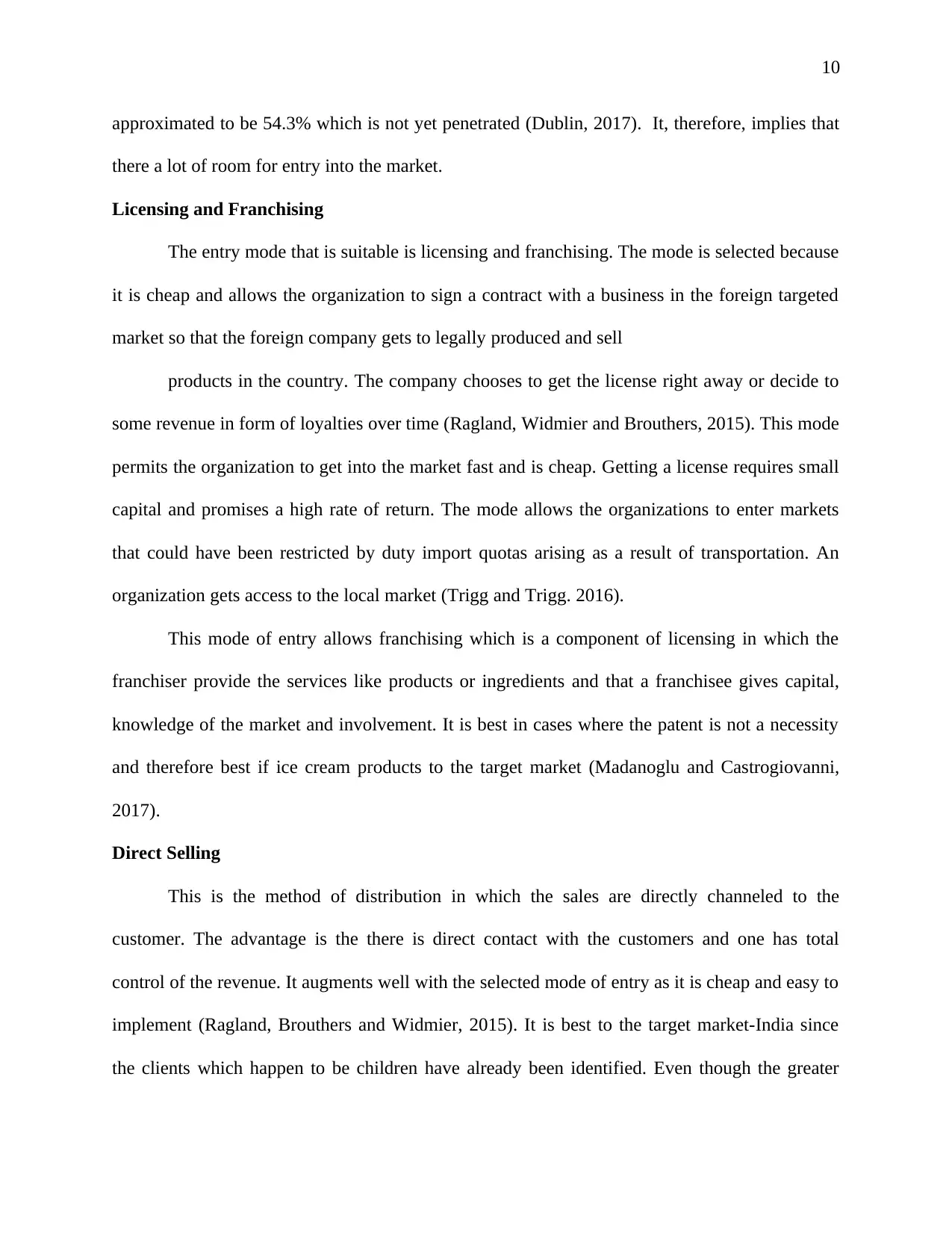
10
approximated to be 54.3% which is not yet penetrated (Dublin, 2017). It, therefore, implies that
there a lot of room for entry into the market.
Licensing and Franchising
The entry mode that is suitable is licensing and franchising. The mode is selected because
it is cheap and allows the organization to sign a contract with a business in the foreign targeted
market so that the foreign company gets to legally produced and sell
products in the country. The company chooses to get the license right away or decide to
some revenue in form of loyalties over time (Ragland, Widmier and Brouthers, 2015). This mode
permits the organization to get into the market fast and is cheap. Getting a license requires small
capital and promises a high rate of return. The mode allows the organizations to enter markets
that could have been restricted by duty import quotas arising as a result of transportation. An
organization gets access to the local market (Trigg and Trigg. 2016).
This mode of entry allows franchising which is a component of licensing in which the
franchiser provide the services like products or ingredients and that a franchisee gives capital,
knowledge of the market and involvement. It is best in cases where the patent is not a necessity
and therefore best if ice cream products to the target market (Madanoglu and Castrogiovanni,
2017).
Direct Selling
This is the method of distribution in which the sales are directly channeled to the
customer. The advantage is the there is direct contact with the customers and one has total
control of the revenue. It augments well with the selected mode of entry as it is cheap and easy to
implement (Ragland, Brouthers and Widmier, 2015). It is best to the target market-India since
the clients which happen to be children have already been identified. Even though the greater
approximated to be 54.3% which is not yet penetrated (Dublin, 2017). It, therefore, implies that
there a lot of room for entry into the market.
Licensing and Franchising
The entry mode that is suitable is licensing and franchising. The mode is selected because
it is cheap and allows the organization to sign a contract with a business in the foreign targeted
market so that the foreign company gets to legally produced and sell
products in the country. The company chooses to get the license right away or decide to
some revenue in form of loyalties over time (Ragland, Widmier and Brouthers, 2015). This mode
permits the organization to get into the market fast and is cheap. Getting a license requires small
capital and promises a high rate of return. The mode allows the organizations to enter markets
that could have been restricted by duty import quotas arising as a result of transportation. An
organization gets access to the local market (Trigg and Trigg. 2016).
This mode of entry allows franchising which is a component of licensing in which the
franchiser provide the services like products or ingredients and that a franchisee gives capital,
knowledge of the market and involvement. It is best in cases where the patent is not a necessity
and therefore best if ice cream products to the target market (Madanoglu and Castrogiovanni,
2017).
Direct Selling
This is the method of distribution in which the sales are directly channeled to the
customer. The advantage is the there is direct contact with the customers and one has total
control of the revenue. It augments well with the selected mode of entry as it is cheap and easy to
implement (Ragland, Brouthers and Widmier, 2015). It is best to the target market-India since
the clients which happen to be children have already been identified. Even though the greater
Secure Best Marks with AI Grader
Need help grading? Try our AI Grader for instant feedback on your assignments.

11
focus is shifted and taken away of the creation of quality goods, there are high returns in the long
run after a sizeable market has been captured (Ragland, Widmier and Brouthers, 2015).
Recommendation
The industry of ice in India is regional and the different brand available focuses only on
small district and sometimes in a single state. The national brands are missing is thus a reason for
slow growth by small-scale players. It gives an opportunity for capturing the market not entered
therefore guaranteeing success.
The organization has to adhere to tough rules and regulations of Advertising Standards
Council on advertising. It is possible by increasing nutritional contents of ice cream product and
making the public aware of the added value.
The company has to balance standardization and adaption strategies by standardizing the
marketing mix, marketing strategies and to follow adaptation that is essential so as to give
satisfaction to the Indian market needs.
Additionally, the company to enter the market using licensing and franchising as it is an
easier, cheap option that allows the company to have control of the direct distribution channel
thus getting the chance to meet with the customers directly.
References
focus is shifted and taken away of the creation of quality goods, there are high returns in the long
run after a sizeable market has been captured (Ragland, Widmier and Brouthers, 2015).
Recommendation
The industry of ice in India is regional and the different brand available focuses only on
small district and sometimes in a single state. The national brands are missing is thus a reason for
slow growth by small-scale players. It gives an opportunity for capturing the market not entered
therefore guaranteeing success.
The organization has to adhere to tough rules and regulations of Advertising Standards
Council on advertising. It is possible by increasing nutritional contents of ice cream product and
making the public aware of the added value.
The company has to balance standardization and adaption strategies by standardizing the
marketing mix, marketing strategies and to follow adaptation that is essential so as to give
satisfaction to the Indian market needs.
Additionally, the company to enter the market using licensing and franchising as it is an
easier, cheap option that allows the company to have control of the direct distribution channel
thus getting the chance to meet with the customers directly.
References
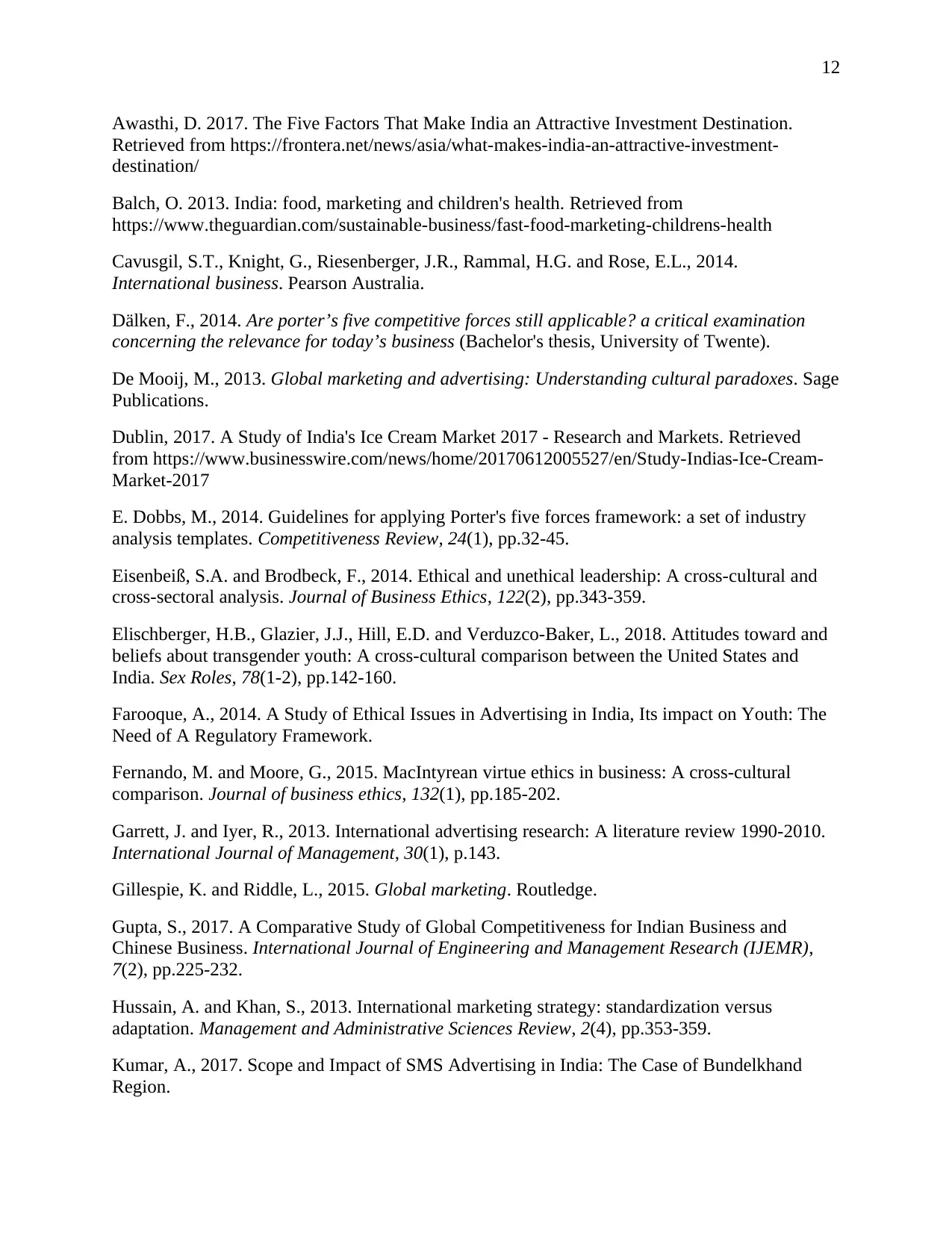
12
Awasthi, D. 2017. The Five Factors That Make India an Attractive Investment Destination.
Retrieved from https://frontera.net/news/asia/what-makes-india-an-attractive-investment-
destination/
Balch, O. 2013. India: food, marketing and children's health. Retrieved from
https://www.theguardian.com/sustainable-business/fast-food-marketing-childrens-health
Cavusgil, S.T., Knight, G., Riesenberger, J.R., Rammal, H.G. and Rose, E.L., 2014.
International business. Pearson Australia.
Dälken, F., 2014. Are porter’s five competitive forces still applicable? a critical examination
concerning the relevance for today’s business (Bachelor's thesis, University of Twente).
De Mooij, M., 2013. Global marketing and advertising: Understanding cultural paradoxes. Sage
Publications.
Dublin, 2017. A Study of India's Ice Cream Market 2017 - Research and Markets. Retrieved
from https://www.businesswire.com/news/home/20170612005527/en/Study-Indias-Ice-Cream-
Market-2017
E. Dobbs, M., 2014. Guidelines for applying Porter's five forces framework: a set of industry
analysis templates. Competitiveness Review, 24(1), pp.32-45.
Eisenbeiß, S.A. and Brodbeck, F., 2014. Ethical and unethical leadership: A cross-cultural and
cross-sectoral analysis. Journal of Business Ethics, 122(2), pp.343-359.
Elischberger, H.B., Glazier, J.J., Hill, E.D. and Verduzco-Baker, L., 2018. Attitudes toward and
beliefs about transgender youth: A cross-cultural comparison between the United States and
India. Sex Roles, 78(1-2), pp.142-160.
Farooque, A., 2014. A Study of Ethical Issues in Advertising in India, Its impact on Youth: The
Need of A Regulatory Framework.
Fernando, M. and Moore, G., 2015. MacIntyrean virtue ethics in business: A cross-cultural
comparison. Journal of business ethics, 132(1), pp.185-202.
Garrett, J. and Iyer, R., 2013. International advertising research: A literature review 1990-2010.
International Journal of Management, 30(1), p.143.
Gillespie, K. and Riddle, L., 2015. Global marketing. Routledge.
Gupta, S., 2017. A Comparative Study of Global Competitiveness for Indian Business and
Chinese Business. International Journal of Engineering and Management Research (IJEMR),
7(2), pp.225-232.
Hussain, A. and Khan, S., 2013. International marketing strategy: standardization versus
adaptation. Management and Administrative Sciences Review, 2(4), pp.353-359.
Kumar, A., 2017. Scope and Impact of SMS Advertising in India: The Case of Bundelkhand
Region.
Awasthi, D. 2017. The Five Factors That Make India an Attractive Investment Destination.
Retrieved from https://frontera.net/news/asia/what-makes-india-an-attractive-investment-
destination/
Balch, O. 2013. India: food, marketing and children's health. Retrieved from
https://www.theguardian.com/sustainable-business/fast-food-marketing-childrens-health
Cavusgil, S.T., Knight, G., Riesenberger, J.R., Rammal, H.G. and Rose, E.L., 2014.
International business. Pearson Australia.
Dälken, F., 2014. Are porter’s five competitive forces still applicable? a critical examination
concerning the relevance for today’s business (Bachelor's thesis, University of Twente).
De Mooij, M., 2013. Global marketing and advertising: Understanding cultural paradoxes. Sage
Publications.
Dublin, 2017. A Study of India's Ice Cream Market 2017 - Research and Markets. Retrieved
from https://www.businesswire.com/news/home/20170612005527/en/Study-Indias-Ice-Cream-
Market-2017
E. Dobbs, M., 2014. Guidelines for applying Porter's five forces framework: a set of industry
analysis templates. Competitiveness Review, 24(1), pp.32-45.
Eisenbeiß, S.A. and Brodbeck, F., 2014. Ethical and unethical leadership: A cross-cultural and
cross-sectoral analysis. Journal of Business Ethics, 122(2), pp.343-359.
Elischberger, H.B., Glazier, J.J., Hill, E.D. and Verduzco-Baker, L., 2018. Attitudes toward and
beliefs about transgender youth: A cross-cultural comparison between the United States and
India. Sex Roles, 78(1-2), pp.142-160.
Farooque, A., 2014. A Study of Ethical Issues in Advertising in India, Its impact on Youth: The
Need of A Regulatory Framework.
Fernando, M. and Moore, G., 2015. MacIntyrean virtue ethics in business: A cross-cultural
comparison. Journal of business ethics, 132(1), pp.185-202.
Garrett, J. and Iyer, R., 2013. International advertising research: A literature review 1990-2010.
International Journal of Management, 30(1), p.143.
Gillespie, K. and Riddle, L., 2015. Global marketing. Routledge.
Gupta, S., 2017. A Comparative Study of Global Competitiveness for Indian Business and
Chinese Business. International Journal of Engineering and Management Research (IJEMR),
7(2), pp.225-232.
Hussain, A. and Khan, S., 2013. International marketing strategy: standardization versus
adaptation. Management and Administrative Sciences Review, 2(4), pp.353-359.
Kumar, A., 2017. Scope and Impact of SMS Advertising in India: The Case of Bundelkhand
Region.
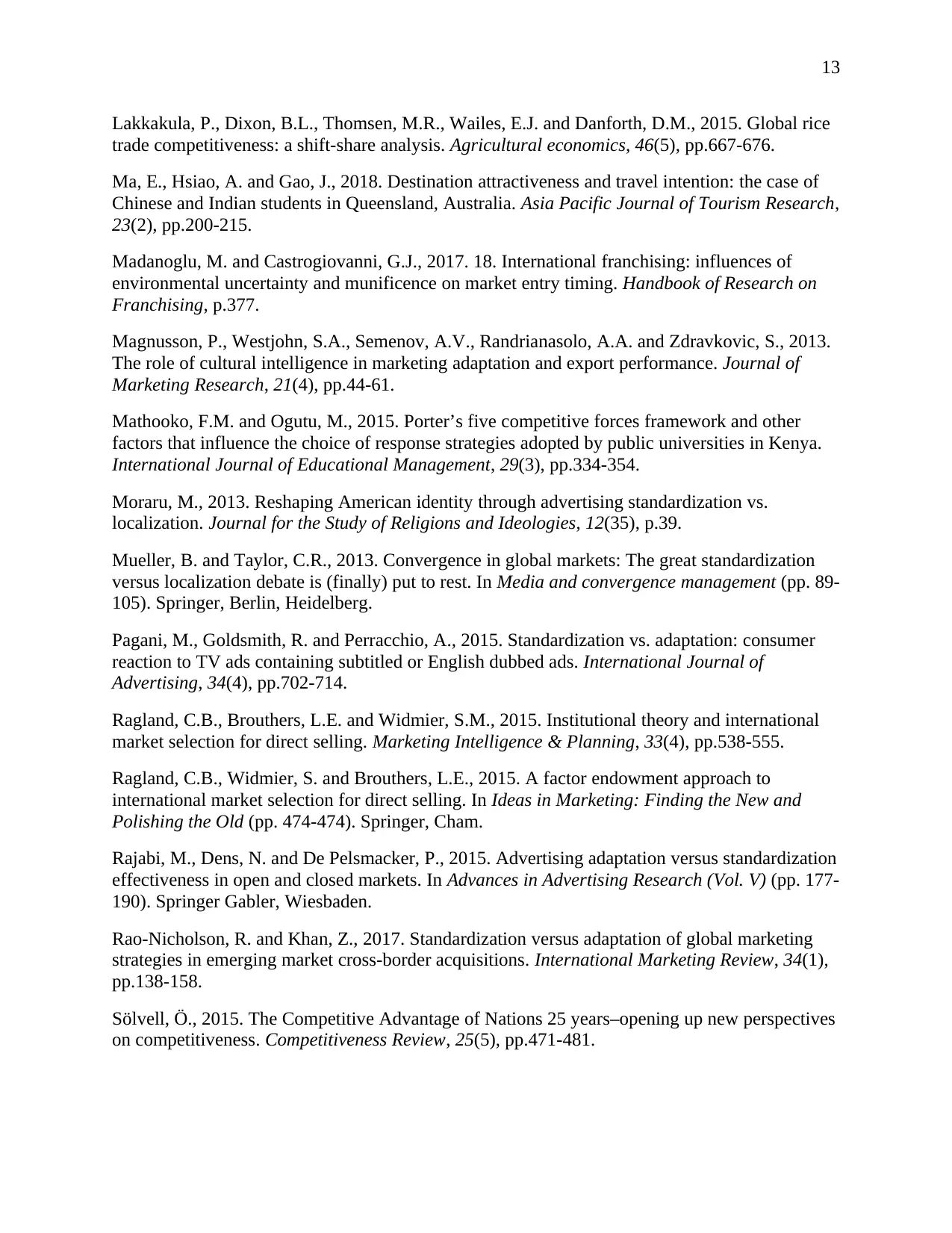
13
Lakkakula, P., Dixon, B.L., Thomsen, M.R., Wailes, E.J. and Danforth, D.M., 2015. Global rice
trade competitiveness: a shift‐share analysis. Agricultural economics, 46(5), pp.667-676.
Ma, E., Hsiao, A. and Gao, J., 2018. Destination attractiveness and travel intention: the case of
Chinese and Indian students in Queensland, Australia. Asia Pacific Journal of Tourism Research,
23(2), pp.200-215.
Madanoglu, M. and Castrogiovanni, G.J., 2017. 18. International franchising: influences of
environmental uncertainty and munificence on market entry timing. Handbook of Research on
Franchising, p.377.
Magnusson, P., Westjohn, S.A., Semenov, A.V., Randrianasolo, A.A. and Zdravkovic, S., 2013.
The role of cultural intelligence in marketing adaptation and export performance. Journal of
Marketing Research, 21(4), pp.44-61.
Mathooko, F.M. and Ogutu, M., 2015. Porter’s five competitive forces framework and other
factors that influence the choice of response strategies adopted by public universities in Kenya.
International Journal of Educational Management, 29(3), pp.334-354.
Moraru, M., 2013. Reshaping American identity through advertising standardization vs.
localization. Journal for the Study of Religions and Ideologies, 12(35), p.39.
Mueller, B. and Taylor, C.R., 2013. Convergence in global markets: The great standardization
versus localization debate is (finally) put to rest. In Media and convergence management (pp. 89-
105). Springer, Berlin, Heidelberg.
Pagani, M., Goldsmith, R. and Perracchio, A., 2015. Standardization vs. adaptation: consumer
reaction to TV ads containing subtitled or English dubbed ads. International Journal of
Advertising, 34(4), pp.702-714.
Ragland, C.B., Brouthers, L.E. and Widmier, S.M., 2015. Institutional theory and international
market selection for direct selling. Marketing Intelligence & Planning, 33(4), pp.538-555.
Ragland, C.B., Widmier, S. and Brouthers, L.E., 2015. A factor endowment approach to
international market selection for direct selling. In Ideas in Marketing: Finding the New and
Polishing the Old (pp. 474-474). Springer, Cham.
Rajabi, M., Dens, N. and De Pelsmacker, P., 2015. Advertising adaptation versus standardization
effectiveness in open and closed markets. In Advances in Advertising Research (Vol. V) (pp. 177-
190). Springer Gabler, Wiesbaden.
Rao-Nicholson, R. and Khan, Z., 2017. Standardization versus adaptation of global marketing
strategies in emerging market cross-border acquisitions. International Marketing Review, 34(1),
pp.138-158.
Sölvell, Ö., 2015. The Competitive Advantage of Nations 25 years–opening up new perspectives
on competitiveness. Competitiveness Review, 25(5), pp.471-481.
Lakkakula, P., Dixon, B.L., Thomsen, M.R., Wailes, E.J. and Danforth, D.M., 2015. Global rice
trade competitiveness: a shift‐share analysis. Agricultural economics, 46(5), pp.667-676.
Ma, E., Hsiao, A. and Gao, J., 2018. Destination attractiveness and travel intention: the case of
Chinese and Indian students in Queensland, Australia. Asia Pacific Journal of Tourism Research,
23(2), pp.200-215.
Madanoglu, M. and Castrogiovanni, G.J., 2017. 18. International franchising: influences of
environmental uncertainty and munificence on market entry timing. Handbook of Research on
Franchising, p.377.
Magnusson, P., Westjohn, S.A., Semenov, A.V., Randrianasolo, A.A. and Zdravkovic, S., 2013.
The role of cultural intelligence in marketing adaptation and export performance. Journal of
Marketing Research, 21(4), pp.44-61.
Mathooko, F.M. and Ogutu, M., 2015. Porter’s five competitive forces framework and other
factors that influence the choice of response strategies adopted by public universities in Kenya.
International Journal of Educational Management, 29(3), pp.334-354.
Moraru, M., 2013. Reshaping American identity through advertising standardization vs.
localization. Journal for the Study of Religions and Ideologies, 12(35), p.39.
Mueller, B. and Taylor, C.R., 2013. Convergence in global markets: The great standardization
versus localization debate is (finally) put to rest. In Media and convergence management (pp. 89-
105). Springer, Berlin, Heidelberg.
Pagani, M., Goldsmith, R. and Perracchio, A., 2015. Standardization vs. adaptation: consumer
reaction to TV ads containing subtitled or English dubbed ads. International Journal of
Advertising, 34(4), pp.702-714.
Ragland, C.B., Brouthers, L.E. and Widmier, S.M., 2015. Institutional theory and international
market selection for direct selling. Marketing Intelligence & Planning, 33(4), pp.538-555.
Ragland, C.B., Widmier, S. and Brouthers, L.E., 2015. A factor endowment approach to
international market selection for direct selling. In Ideas in Marketing: Finding the New and
Polishing the Old (pp. 474-474). Springer, Cham.
Rajabi, M., Dens, N. and De Pelsmacker, P., 2015. Advertising adaptation versus standardization
effectiveness in open and closed markets. In Advances in Advertising Research (Vol. V) (pp. 177-
190). Springer Gabler, Wiesbaden.
Rao-Nicholson, R. and Khan, Z., 2017. Standardization versus adaptation of global marketing
strategies in emerging market cross-border acquisitions. International Marketing Review, 34(1),
pp.138-158.
Sölvell, Ö., 2015. The Competitive Advantage of Nations 25 years–opening up new perspectives
on competitiveness. Competitiveness Review, 25(5), pp.471-481.
Paraphrase This Document
Need a fresh take? Get an instant paraphrase of this document with our AI Paraphraser

14
Srivastava, E., Maheswarappa, S.S. and Sivakumaran, B., 2017. Nostalgic advertising in India: a
content analysis of Indian TV advertisements. Asia Pacific Journal of Marketing and Logistics,
29(1), pp.47-69.
Stock, R.M., Strecker, M.M. and Bieling, G.I., 2016. Organizational work–family support as
universal remedy? A cross-cultural comparison of China, India and the USA. The International
Journal of Human Resource Management, 27(11), pp.1192-1216.
Tan, K.G., 2017. Inaugural 2016 Ease of Doing Business Index on Attractiveness to Investors,
Business Friendliness and Competitive Policies (EDB Index ABC) for 21 Sub-national
Economies of India. World Scientific.
techsciresearch , 2018. India Ice Cream Market Forecast to Grow at CAGR 17% till 2021.
Retrieved from https://www.techsciresearch.com/news/1898-india-ice-cream-market-forecast-to-
grow-at-cagr-17-till-2021.html
Thomas, M. 2017. In hot and humid India, the growth in ice cream sales is outpacing the rest of
the world. Retrieved https://qz.com/1024565/in-hot-and-humid-india-the-growth-in-ice-cream-
sales-is-outpacing-the-rest-of-the-world/
Trehan, K. and Gupta, A., 2015. Brands Explore Human Relationships for Consumer
Engagement: A Critical Analysis of Television Advertising in India. Indian Journal of
Marketing, 45(12), pp.32-46.
Trigg, M.C. and Trigg, D., 2016. International business–operating abroad. In The Global
Business Handbook (pp. 35-48). Routledge.
Vora, R. & Damor, K. 2013. India's No.2 ice cream maker heads north. Retrieved from
http://www.business-standard.com/article/companies/india-s-no-2-ice-cream-maker-heads-north-
112053000060_1.html
Wei, S.Y.P. and Yazdanifard, R., 2014. Comparison on the impact of standardization and
adaptation on international marketing. Global Journal of Management And Business Research.
World Economic Forum, 2015. Why is India the most attractive market for investments?
Retrieved from http://www.dnaindia.com/business/report-why-is-india-the-most-attractive-
market-for-investments-2136592
Srivastava, E., Maheswarappa, S.S. and Sivakumaran, B., 2017. Nostalgic advertising in India: a
content analysis of Indian TV advertisements. Asia Pacific Journal of Marketing and Logistics,
29(1), pp.47-69.
Stock, R.M., Strecker, M.M. and Bieling, G.I., 2016. Organizational work–family support as
universal remedy? A cross-cultural comparison of China, India and the USA. The International
Journal of Human Resource Management, 27(11), pp.1192-1216.
Tan, K.G., 2017. Inaugural 2016 Ease of Doing Business Index on Attractiveness to Investors,
Business Friendliness and Competitive Policies (EDB Index ABC) for 21 Sub-national
Economies of India. World Scientific.
techsciresearch , 2018. India Ice Cream Market Forecast to Grow at CAGR 17% till 2021.
Retrieved from https://www.techsciresearch.com/news/1898-india-ice-cream-market-forecast-to-
grow-at-cagr-17-till-2021.html
Thomas, M. 2017. In hot and humid India, the growth in ice cream sales is outpacing the rest of
the world. Retrieved https://qz.com/1024565/in-hot-and-humid-india-the-growth-in-ice-cream-
sales-is-outpacing-the-rest-of-the-world/
Trehan, K. and Gupta, A., 2015. Brands Explore Human Relationships for Consumer
Engagement: A Critical Analysis of Television Advertising in India. Indian Journal of
Marketing, 45(12), pp.32-46.
Trigg, M.C. and Trigg, D., 2016. International business–operating abroad. In The Global
Business Handbook (pp. 35-48). Routledge.
Vora, R. & Damor, K. 2013. India's No.2 ice cream maker heads north. Retrieved from
http://www.business-standard.com/article/companies/india-s-no-2-ice-cream-maker-heads-north-
112053000060_1.html
Wei, S.Y.P. and Yazdanifard, R., 2014. Comparison on the impact of standardization and
adaptation on international marketing. Global Journal of Management And Business Research.
World Economic Forum, 2015. Why is India the most attractive market for investments?
Retrieved from http://www.dnaindia.com/business/report-why-is-india-the-most-attractive-
market-for-investments-2136592
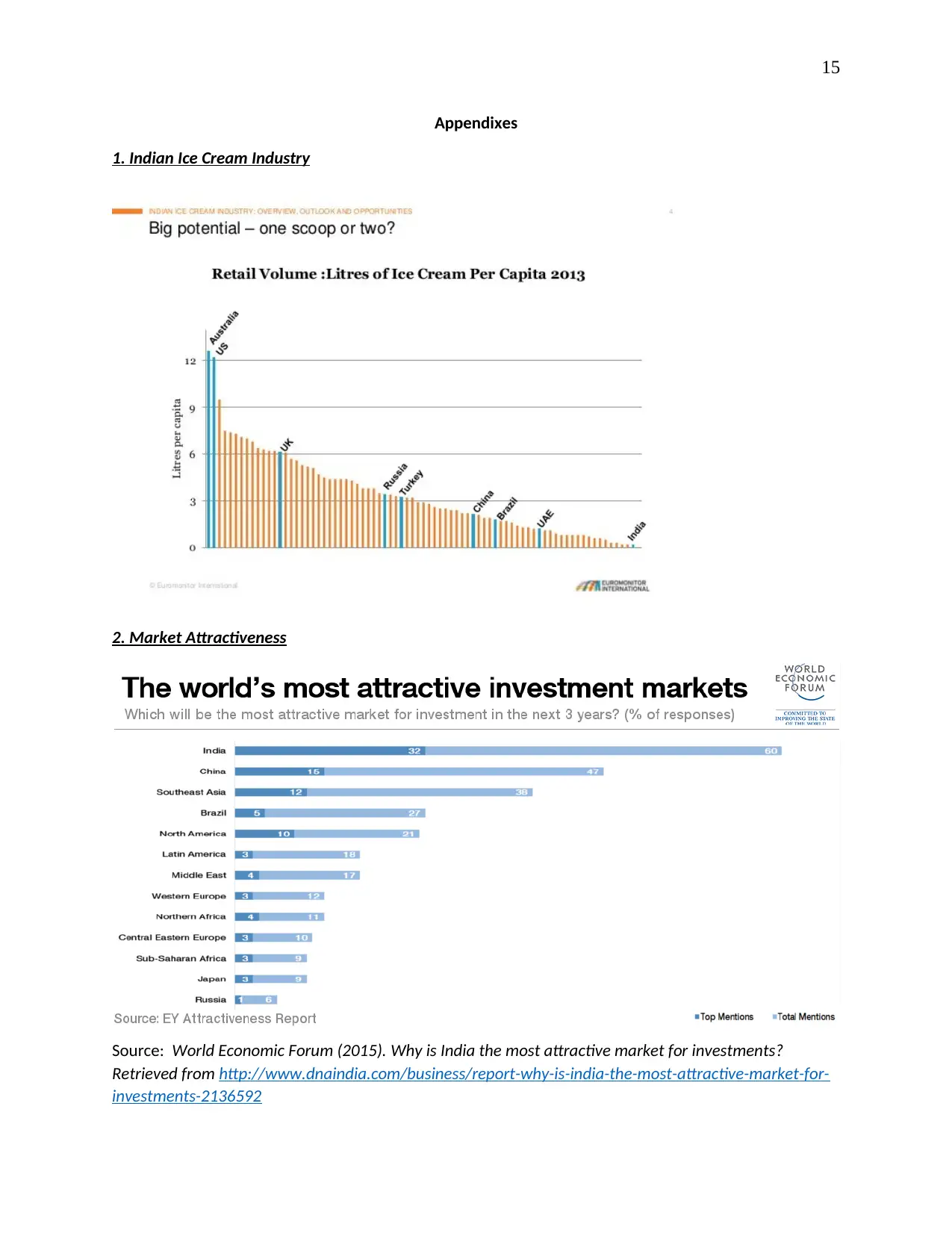
15
Appendixes
1. Indian Ice Cream Industry
2. Market Attractiveness
Source: World Economic Forum (2015). Why is India the most attractive market for investments?
Retrieved from http://www.dnaindia.com/business/report-why-is-india-the-most-attractive-market-for-
investments-2136592
Appendixes
1. Indian Ice Cream Industry
2. Market Attractiveness
Source: World Economic Forum (2015). Why is India the most attractive market for investments?
Retrieved from http://www.dnaindia.com/business/report-why-is-india-the-most-attractive-market-for-
investments-2136592

16
3. Market share
The profile of competitors
The Competitors
Gujarat Co-operative Milk Marketing Federation: The company has varied products lines and
ice cream, dessert and chocolates are among the products. It has retail stores in various parts of
India as well as selling its products through the use of distributors and through the use of
online. It as well deals with export of excess products to Singapore, US and Gulf countries.
Unilever: This company entered India to specialize particularly is Ice cream. Due to reputation
as a result of its global nature, the organization enjoys an expansive distribution network
globally.
National Dairy Development Board: This is under the government and was set to gather the
needs and aspirations of dairy farmers in buying and selling dairy products for farmers. It has
integrated many dairy cooperatives with use of Anand Pattern that link societies to the state
federation with use of a three-tier structure.
Vadilal industries: The Company has a wide reach that get attributed to the capability to
attracted different segments in the market with use of varied ranges of products. It caters
different tastes preferences, and prices.
RJ Corp: The company produces ice cream along-side other food products in a form of a
restaurant as well as banking survices specifically set for its customers. It is based in based in
Gurgaon and has operations in other countries like Nepal, Uganda among others. Another
subsidiary is operated by Jaipuria Group.
3. Market share
The profile of competitors
The Competitors
Gujarat Co-operative Milk Marketing Federation: The company has varied products lines and
ice cream, dessert and chocolates are among the products. It has retail stores in various parts of
India as well as selling its products through the use of distributors and through the use of
online. It as well deals with export of excess products to Singapore, US and Gulf countries.
Unilever: This company entered India to specialize particularly is Ice cream. Due to reputation
as a result of its global nature, the organization enjoys an expansive distribution network
globally.
National Dairy Development Board: This is under the government and was set to gather the
needs and aspirations of dairy farmers in buying and selling dairy products for farmers. It has
integrated many dairy cooperatives with use of Anand Pattern that link societies to the state
federation with use of a three-tier structure.
Vadilal industries: The Company has a wide reach that get attributed to the capability to
attracted different segments in the market with use of varied ranges of products. It caters
different tastes preferences, and prices.
RJ Corp: The company produces ice cream along-side other food products in a form of a
restaurant as well as banking survices specifically set for its customers. It is based in based in
Gurgaon and has operations in other countries like Nepal, Uganda among others. Another
subsidiary is operated by Jaipuria Group.
Secure Best Marks with AI Grader
Need help grading? Try our AI Grader for instant feedback on your assignments.
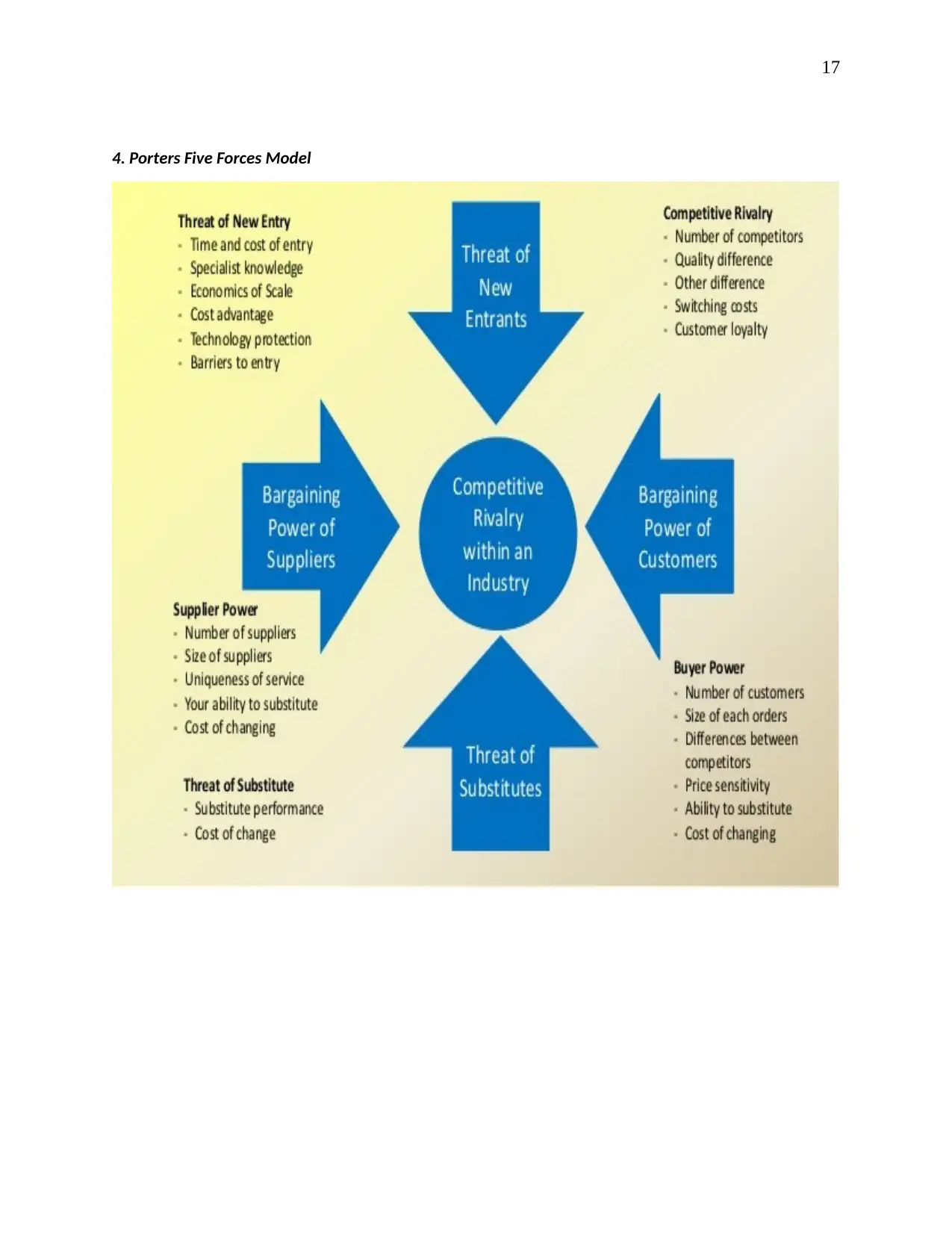
17
4. Porters Five Forces Model
4. Porters Five Forces Model
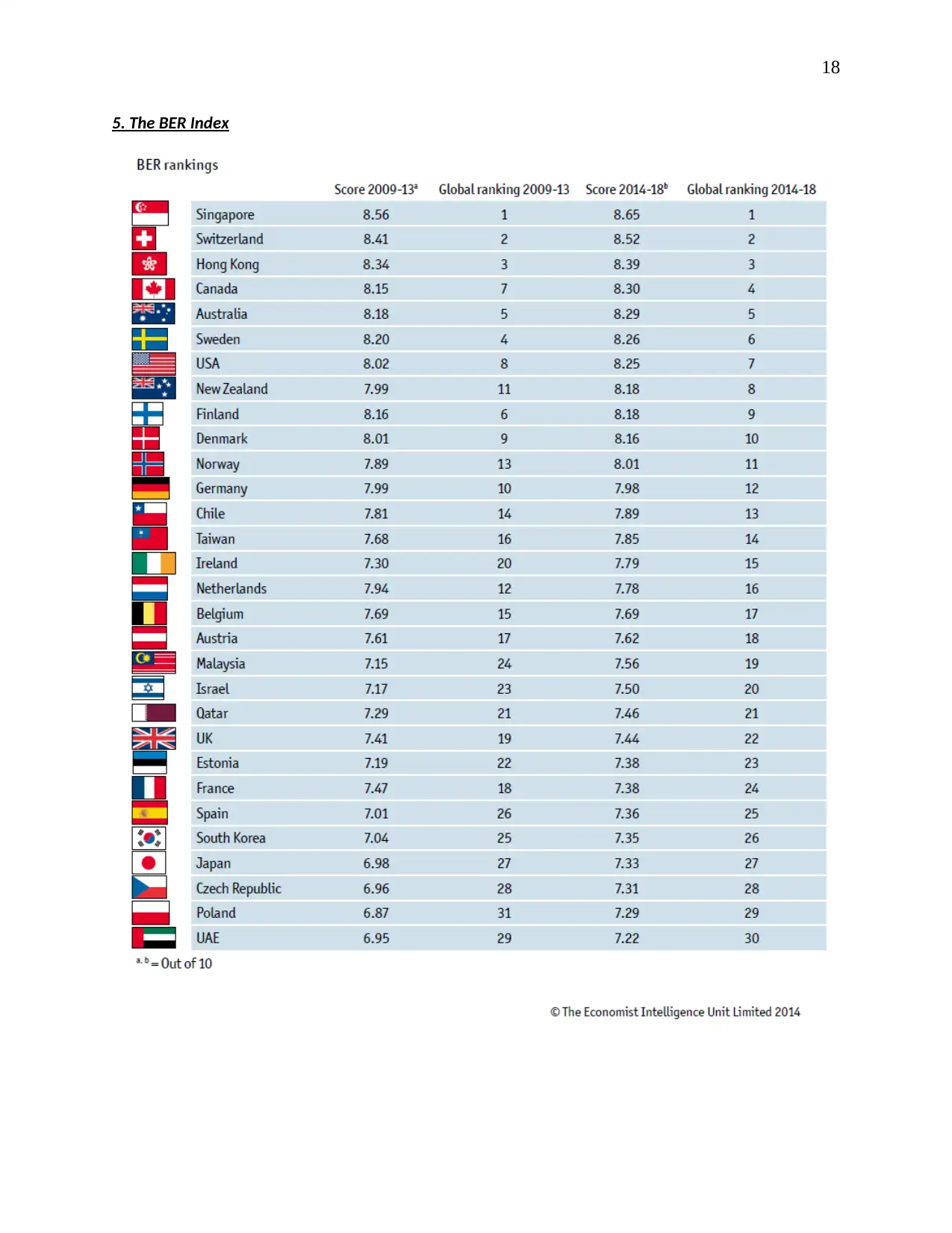
18
5. The BER Index
5. The BER Index
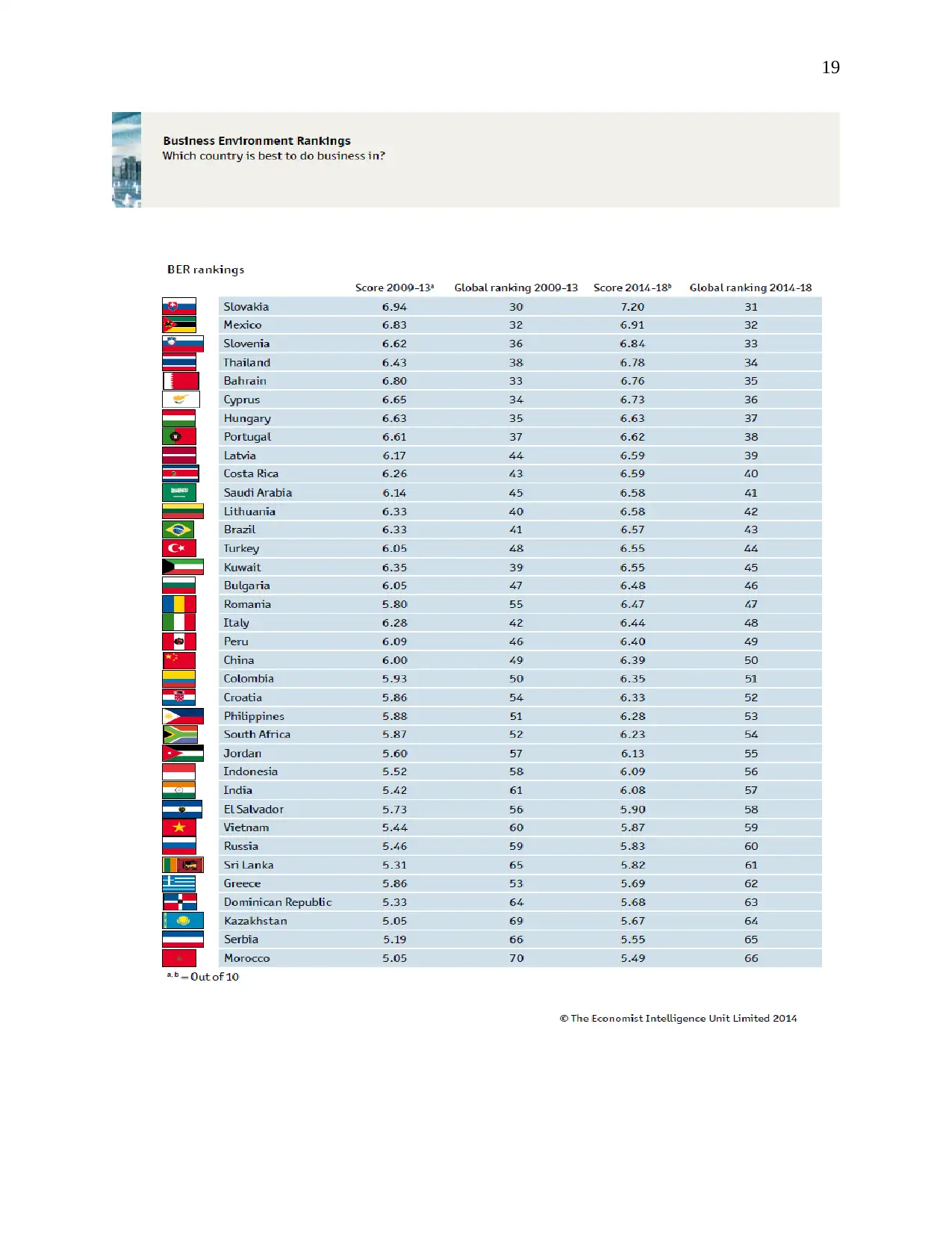
19
Paraphrase This Document
Need a fresh take? Get an instant paraphrase of this document with our AI Paraphraser

20
1 out of 20
Your All-in-One AI-Powered Toolkit for Academic Success.
+13062052269
info@desklib.com
Available 24*7 on WhatsApp / Email
![[object Object]](/_next/static/media/star-bottom.7253800d.svg)
Unlock your academic potential
© 2024 | Zucol Services PVT LTD | All rights reserved.